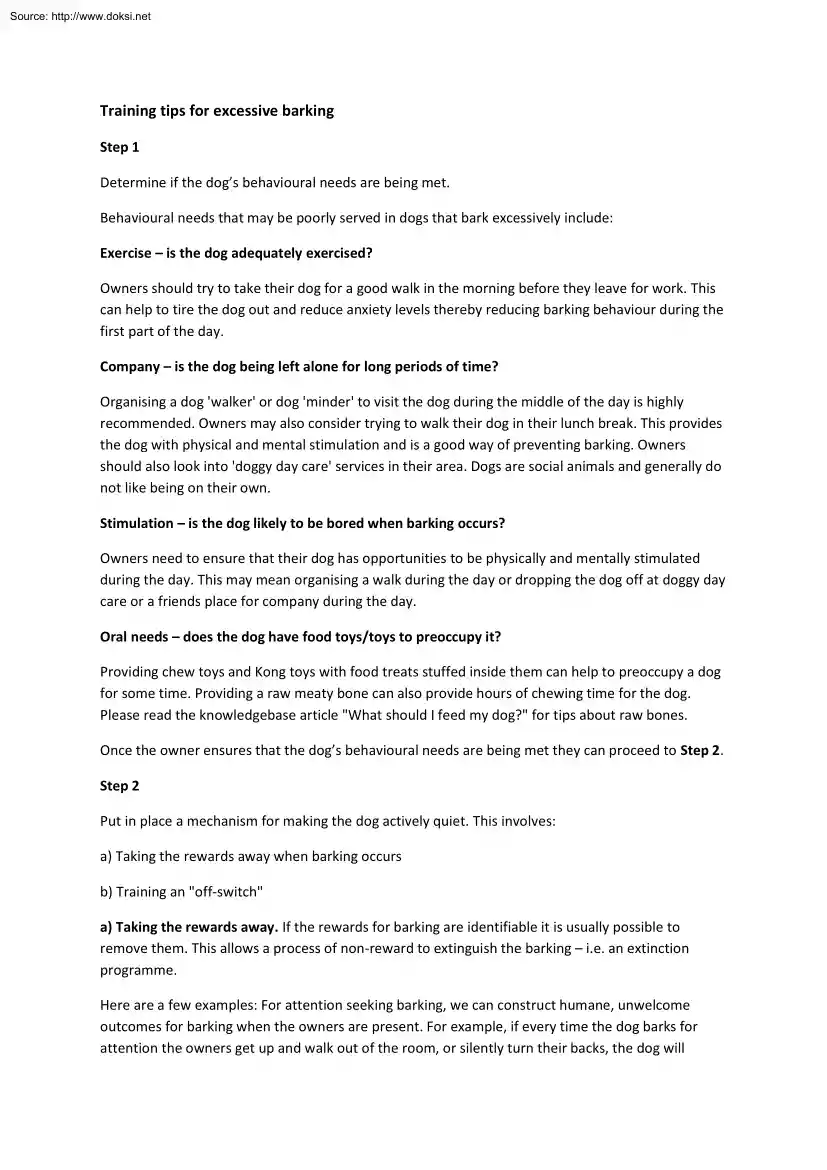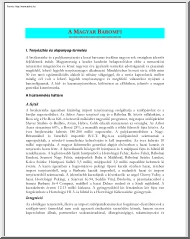Datasheet
Year, pagecount:2013, 2 page(s)
Language:English
Downloads:5
Uploaded:March 07, 2019
Size:633 KB
Institution:
-
Comments:
Attachment:-
Download in PDF:Please log in!
Comments
No comments yet. You can be the first!Most popular documents in this category
Content extract
Source: http://www.doksinet Training tips for excessive barking Step 1 Determine if the dog’s behavioural needs are being met. Behavioural needs that may be poorly served in dogs that bark excessively include: Exercise – is the dog adequately exercised? Owners should try to take their dog for a good walk in the morning before they leave for work. This can help to tire the dog out and reduce anxiety levels thereby reducing barking behaviour during the first part of the day. Company – is the dog being left alone for long periods of time? Organising a dog walker or dog minder to visit the dog during the middle of the day is highly recommended. Owners may also consider trying to walk their dog in their lunch break This provides the dog with physical and mental stimulation and is a good way of preventing barking. Owners should also look into doggy day care services in their area. Dogs are social animals and generally do not like being on their own. Stimulation – is the dog likely
to be bored when barking occurs? Owners need to ensure that their dog has opportunities to be physically and mentally stimulated during the day. This may mean organising a walk during the day or dropping the dog off at doggy day care or a friends place for company during the day. Oral needs – does the dog have food toys/toys to preoccupy it? Providing chew toys and Kong toys with food treats stuffed inside them can help to preoccupy a dog for some time. Providing a raw meaty bone can also provide hours of chewing time for the dog Please read the knowledgebase article "What should I feed my dog?" for tips about raw bones. Once the owner ensures that the dog’s behavioural needs are being met they can proceed to Step 2. Step 2 Put in place a mechanism for making the dog actively quiet. This involves: a) Taking the rewards away when barking occurs b) Training an "off-switch" a) Taking the rewards away. If the rewards for barking are identifiable it is usually
possible to remove them. This allows a process of non-reward to extinguish the barking – ie an extinction programme. Here are a few examples: For attention seeking barking, we can construct humane, unwelcome outcomes for barking when the owners are present. For example, if every time the dog barks for attention the owners get up and walk out of the room, or silently turn their backs, the dog will Source: http://www.doksinet eventually learn that barking is counter-productive. Owners need to be aware that the dog may tend to try even harder to get noticed in the early stages of this training. Similarly, if the owners resolve to never enter the home when the dog is actively barking the dog will never associate barking with the return of their owner. b) Training an "off-switch". Only when an extinction programme is in place (part a), is it time to think of ways of stopping the barking that remains. The 8 Point Plan for training dogs to stop barking 1. Find a way of
encouraging the dog to bark You may find it will bark out of excitement in response to the door bell or if you hold its food bowl up in the air, or you may only need to use a food reward or a toy. 2. When, with a bit of friendly teasing, your dog does bark, praise it and start to repeat the word speak! during the vocalisation. 3. Repeat the exercise until the dog associates the word speak with the act of barking and is vocalising merrily for rewards. 4. Reserve praise and rewards for times when the dog has barked only after having heard the command to speak. This places the bark under stimulus control (ie puts it on command) 5. Introduce the word quiet! or stop! while your dog is barking on command, and give it a toy or food treat as soon as it stops barking. 6. Reserve praise and rewards for times when the dog has stopped barking only after having heard the command to be quiet! or stop! This places the termination of barking under stimulus control. 7. Repeat step 6 whenever the dog is
barking without being told to speak This links the signal to be quiet with the cessation of spontaneous barking. Reward liberally for all appropriate responses at this stage .of course! 8. Issue your friendly neighbours with a supply of rewards and instruct them to repeat step 6 whenever the dog is barking. Note: Anti-barking collars constitute a form of punishment and are an unreliable remedy – they do not address the cause of the problem and are easy to abuse. Your dog will be punished for every bark, some of which will be appropriate, and he will not learn an alternative, acceptable behaviour. RSPCA Australia does not recommend the use of these collars. Finally, please do consult with your vet for further advice. Reference: Ethology of barking -Why Do Dogs Bark? Dr P McGreevy, Urban Animal Management Conference Proceedings 2004
to be bored when barking occurs? Owners need to ensure that their dog has opportunities to be physically and mentally stimulated during the day. This may mean organising a walk during the day or dropping the dog off at doggy day care or a friends place for company during the day. Oral needs – does the dog have food toys/toys to preoccupy it? Providing chew toys and Kong toys with food treats stuffed inside them can help to preoccupy a dog for some time. Providing a raw meaty bone can also provide hours of chewing time for the dog Please read the knowledgebase article "What should I feed my dog?" for tips about raw bones. Once the owner ensures that the dog’s behavioural needs are being met they can proceed to Step 2. Step 2 Put in place a mechanism for making the dog actively quiet. This involves: a) Taking the rewards away when barking occurs b) Training an "off-switch" a) Taking the rewards away. If the rewards for barking are identifiable it is usually
possible to remove them. This allows a process of non-reward to extinguish the barking – ie an extinction programme. Here are a few examples: For attention seeking barking, we can construct humane, unwelcome outcomes for barking when the owners are present. For example, if every time the dog barks for attention the owners get up and walk out of the room, or silently turn their backs, the dog will Source: http://www.doksinet eventually learn that barking is counter-productive. Owners need to be aware that the dog may tend to try even harder to get noticed in the early stages of this training. Similarly, if the owners resolve to never enter the home when the dog is actively barking the dog will never associate barking with the return of their owner. b) Training an "off-switch". Only when an extinction programme is in place (part a), is it time to think of ways of stopping the barking that remains. The 8 Point Plan for training dogs to stop barking 1. Find a way of
encouraging the dog to bark You may find it will bark out of excitement in response to the door bell or if you hold its food bowl up in the air, or you may only need to use a food reward or a toy. 2. When, with a bit of friendly teasing, your dog does bark, praise it and start to repeat the word speak! during the vocalisation. 3. Repeat the exercise until the dog associates the word speak with the act of barking and is vocalising merrily for rewards. 4. Reserve praise and rewards for times when the dog has barked only after having heard the command to speak. This places the bark under stimulus control (ie puts it on command) 5. Introduce the word quiet! or stop! while your dog is barking on command, and give it a toy or food treat as soon as it stops barking. 6. Reserve praise and rewards for times when the dog has stopped barking only after having heard the command to be quiet! or stop! This places the termination of barking under stimulus control. 7. Repeat step 6 whenever the dog is
barking without being told to speak This links the signal to be quiet with the cessation of spontaneous barking. Reward liberally for all appropriate responses at this stage .of course! 8. Issue your friendly neighbours with a supply of rewards and instruct them to repeat step 6 whenever the dog is barking. Note: Anti-barking collars constitute a form of punishment and are an unreliable remedy – they do not address the cause of the problem and are easy to abuse. Your dog will be punished for every bark, some of which will be appropriate, and he will not learn an alternative, acceptable behaviour. RSPCA Australia does not recommend the use of these collars. Finally, please do consult with your vet for further advice. Reference: Ethology of barking -Why Do Dogs Bark? Dr P McGreevy, Urban Animal Management Conference Proceedings 2004





